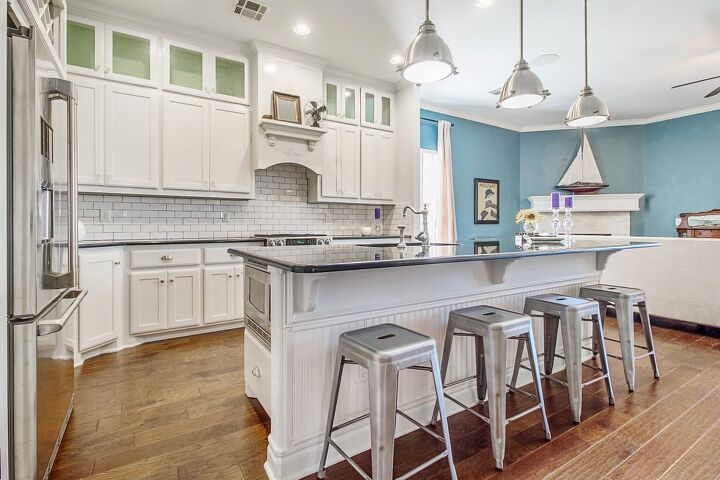Design Trends That Look Great But Aren’t Practical

Do you ever feel like your home is missing the mark as you thumb through the glossy pages of interior design magazines? Or you start thinking you have a lot of work to do as you scroll through the latest design trends on Pinterest. Well, don’t let it stress you out. These design trends might look incredible, but they aren’t always practical.
Using a barn door for your bathroom, swapping out upper cabinets for open shelving, and chandeliers over the tub look great. But these design trends aren’t practical for real life. Vessel sinks are beautiful but come with cleaning challenges. Living walls take work. Other impractical design trends are backless bar stools, dining benches, and pot racks.
When you start to imagine about how a fabulous-looking design option would actually work in real life, it makes you think twice. Not sure which ones fail the real life test? Check our list of fabulous design trends that nail it in photos, but fall short when it comes to day-to-day living.
Interior Design Trends That Don’t Pass The Real-Life Test (But Look Great In Photos)
To be clear, some of these design choices might work out okay for you depending on your particular lifestyle. For example, consider backless bar stools. Maybe you only use them occasionally or only sit on them for a few minutes at a time.
But most of the time, these trends don’t stand up to everyday living. These are styles that look incredible because they’re perfectly styled for a photo shoot.
Some of the trends will work under certain conditions, but not typically for the one they’re shown performing in a Pinterest photo. So, this list is here to help save you from making a choice you might regret later. It doesn’t mean you can’t use these trends in your home, but it should make you think twice before you do.
1. Vessel Sinks
Vessel sinks look beautiful and come in an eclectic assortment of styles, colors, and materials. The bowl-shaped sinks sit atop the bathroom counter and typically accompany a tall or wall-mounted faucet.
The raised sides of vessel sinks give them their unique, beautiful appearance, but they also add a bit of impracticality. The design makes the sinks more susceptible to chips and damage. Vessel sinks also tend to cause a bit more splash-up and certain shapes and sizes make it tricky to wash your face.
They’re also a challenge when it comes to cleaning, since you need to get between the bottom of the sink and the countertop. Also, many vessel sinks are glass, which tends to show water spots more, leading to more frequent wipe-downs.
2. Open Shelving Instead Of Upper Cabinets
Pictures of bright, airy kitchens with sleek open shelving instead of upper cabinets look great for the camera. The well-styled floating shelves create a visually appealing aesthetic and make the space feel more open.
For a long time, switching out upper cabinets with open shelves was all the rage. However, reality started to sink in and as time passed, people realized how impractical this trend was.
First, you likely don’t have enough decorative pieces to fill every bit of open shelving. Many people have mismatched cups, plates, and other odds and ends they’d rather not put on display. However, you remove a large chunk of hidden storage when you rip out all of the upper cabinets.
Plus, even if you did have amazing-looking dishware and unique pieces, imagine keeping it all clean. The more open shelving, the more dust.
3. Barn Doors For Bathrooms
Barn doors saw a boon during the modern farmhouse craze, but they aren’t always a practical choice. Besides the point that the farmhouse look is seeing a bit of a slowdown, barn doors don’t work too well in certain applications.
Primarily, it’s not the best choice to use barn doors for bathrooms. Often, the reason homeowners use a barn door is space. There’s no room for a traditional door, so an obvious solution is a sliding barn door.
However, barn doors don’t do a very good job of blocking noises or smells. Therefore, they aren’t the most practical choice for bathrooms. Instead, your better option would be a pocket door or even a bi-fold door if you’re limited on budget and space.
4. Wallpaper In Full Bathrooms
Full bathrooms create a lot of moisture from steamy showers, filling bathtubs, and daily use. This humid environment is not ideal for porous wallpaper and the glue or adhesive behind it. In time, it will start to peel, bubble, and grow mildew or mold.
It’s common to see bold wallpaper in powder rooms. But avoid using it in full bathrooms, unless you have incredible ventilation and use wallpaper made specifically for high-moisture environments.
5. Backless Bar Stools
Adding a few bar stools to your kitchen island is a common design move. It looks great and it's functional. However, many design photos showcase backless bar stools because they take up less visual space, don’t block the island, and look great.
However, for anyone sitting on those stools for a long period of time, they aren’t very comfortable. Therefore, don’t forget why you need stools in the first place, and make sure they provide appropriate support.
6. Dining Benches
Dining benches present a similar challenge to backless bar stools. They aren’t the most comfortable if you’re sitting in them for an extended period of time during a dinner date or game night. You see them often in styled dining room photos, and they undoubtedly work well in small spaces. However, know that they won’t be the most comfortable option.
7. Exposed Light Bulbs
Another popular design trend that isn’t practical is using exposed light bulbs everywhere. Imagine the Edison bulbs or similar fixtures that are often showcased in style magazines and other sources.
Exposed bulbs can become overpowering and wear out eyes over time. They tend to take over a space. When you don’t have a way to diffuse the light, it soon becomes all you see.
8. Pot Racks
Hanging pot racks are great space savers and make using your pots and pans convenient. Plus, they always look fabulous when you see them in photographs. But take a moment and think about how your pots look.
Are they always bright and shiny like the ones you see in those pictures? Probably not. More likely, your pots have scuffs, scratches, scorch marks, and worn-out bottoms.
9. Greenery Everywhere And Living Walls
Pictures of spaces full of lush, vibrant greenery look stunning. And it’s true that using plants, herbs, and other natural elements brings life to your home. But some of these photos go over the top with hanging greenery everywhere and living walls featuring floor-to-ceiling plant life.
In reality, imagine taking care of all of these plants every day. Even more so, can you imagine what they’d look like if you weren’t able to care for them properly? You’d have dead plants all over the place.
So, this trend might look great, but it isn’t practical. Definitely use greenery in your home. It’s a great way to give your bathroom a spa vibe or cozy up a room. But keep it to a manageable amount for your lifestyle.
10. Placing The Desk In The Middle Of A Home Office
A lot of interior design photos of home offices show a statement desk in the middle of the room. The overall space looks amazing and definitely presents a place you’d love to work.
But how practical is it to have your desk in the middle of a space? Don’t you need outlets for your computer? Do you want cords traveling across your floor?
This look might work if you have a solution for the outlet conundrum. For example, some people do have outlets installed on the floor (especially in applications like a kitchen island). But make sure you know about these issues before you decide to design your home office this way.
11. Chandeliers Over The Bathtub
Pretty much every design photo of a bathtub shows some stunning chandelier hanging above it. It looks incredible, but then people try to recreate this look in their bathrooms, not paying attention to the code requirements.
According to the National Electrical Code🄬, the bottom of the chandelier needs to be at least 8 feet above the highest point of your tub. Otherwise, it needs to hang at least three feet away from your tub. The reason for these guidelines is a big one -- safety.
The last thing you need if you fall is to grab the chandelier and pull it out of the ceiling, electrical wires and all, on top of you and into a tub full of water. See the problem here?
Keep Real Life In Mind When Finalizing Your Design Choices
The most important thing to keep in mind when you’re designing your space is that it should reflect your style, but it also needs to function well.
That’s the hallmark of great design -- a perfect blend of form and function. But when you go off of designer photos alone, you often end up with a lot of impractical design trends.
So, get inspiration from magazines, social media, and other places. Gather ideas. But then consider how these designs will hold up in real life before you incorporate them into your home.
Related Guides:

Stacy Randall is a wife, mother, and freelance writer from NOLA that has always had a love for DIY projects, home organization, and making spaces beautiful. Together with her husband, she has been spending the last several years lovingly renovating her grandparent's former home, making it their own and learning a lot about life along the way.
More by Stacy Randall














![10 Best Electric Lawn Mowers - [2022 Reviews & Top Rated Models]](https://cdn-fastly.upgradedhome.com/media/2023/07/31/9070486/10-best-electric-lawn-mowers-2022-reviews-top-rated-models.jpg?size=350x220)









![How To Reset A Whirlpool Cabrio Washer [In 5 Easy Steps!]](https://cdn-fastly.upgradedhome.com/media/2023/07/31/9076531/how-to-reset-a-whirlpool-cabrio-washer-in-5-easy-steps.jpg?size=350x220)
![Standard Dining Room Table Dimensions [for 4, 6, 8, 10 and 12 People]](https://cdn-fastly.upgradedhome.com/media/2023/07/31/9074335/standard-dining-room-table-dimensions-for-4-6-8-10-and-12-people.jpg?size=350x220)

